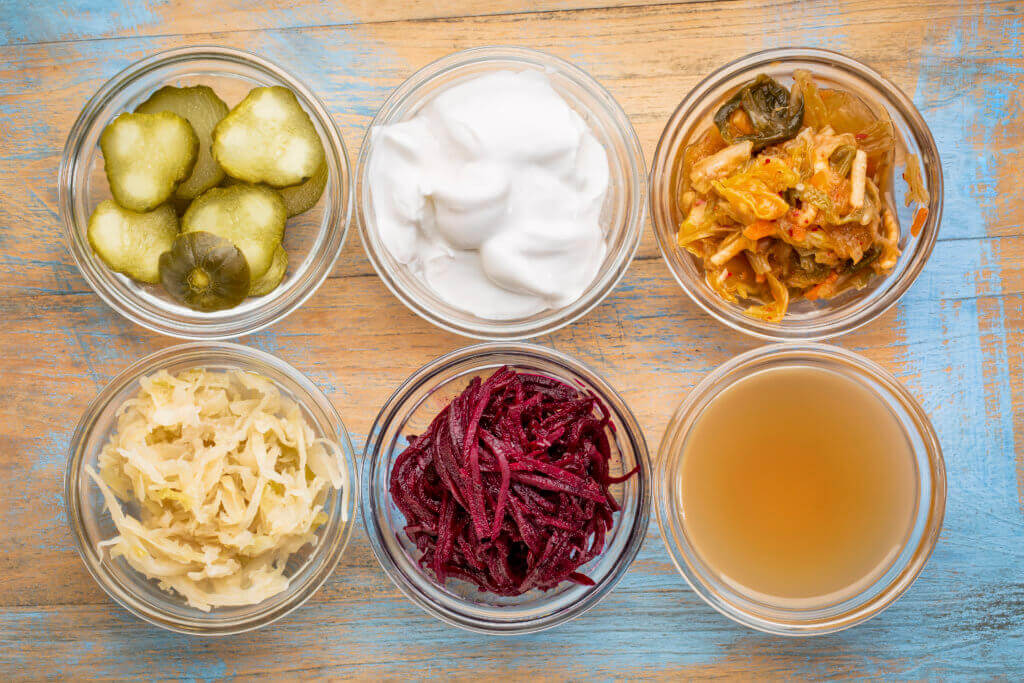
Prebiotics vs Probiotics: Gut Basics
The lining of your gut is made up of trillions of bacteria, fungi, and other microbes that create a micro-ecosystem called microbiome.1 The microbiome plays a key role in your health by helping control digestion. Benefits of the microbiome help your immune system, as well as affecting your mood and behavior.2 The friendly microbes destroy harmful bacteria and other microorganisms and produce vitamin K, folate and short-chain fatty acids.3 An imbalance of unhealthy and healthy microbes in the intestines have been linked to insulin resistance, weight gain, inflammation, and obesity. Other links are inflammatory bowel disease, high blood sugar, high cholesterol, colorectal cancer, and other disorders.4
Nourish Your Gut
To maintain a healthy microbiome, you must nourish a balance of nearly 1,000 different species of bacteria in your gut.5 There are two ways to create and maintain a healthy gut: 1) Prebiotics to help existing microbes grow 2) probiotics to increase the number of living microbes in your system.
Prebiotics vs Probiotics
Prebiotics
These natural, non-digestible food components (typically high-fiber foods) that act as food for human microflora. Often, prebiotics are used with the intention of improving the balance of these microorganisms.6 These act like fertilizer to stimulate the growth of healthy bacteria in the gut.
You can find prebiotics in many fruits and vegetables, complex carbohydrates (fiber and resistant starch). Complex carbs aren’t digestible. They pass through the digestive system to become food for the bacteria and other microbes.7
Other foods include:
- Lentils, chickpeas and beans
- Oats
- Bananas
- Artichokes
- Asparagus
- Garlic
- Leeks
- Onions
- Nuts
- Whole grains
- Greens
- Soybeans
Probiotics
Probiotics are foods or supplements that contain live microorganisms—specific strains of bacteria. Most are intended to add to or maintain the “good” bacteria (normal microflora) in the body.8
Purna Kashyap, a gastroenterologist at the Mayo Clinic and member of the scientific advisory board for the American Gastroenterological Association Center for Gut Microbiome Research and Education says, “When it comes to probiotics, naturally occurring sources always trump supplements.”9
Some of the most common probiotic food is fermented dairy foods including yogurt, kefir products and aged cheeses, which contain live cultures (for example, bifidobacteria and lactobacilli)10 that are left in the final product. Other sources include:
- Sauerkraut
- Kombucha
- Kimchi
- Miso
- Tempeh
Get in my belly!
To help support the growth of healthy microbes in your gut, eat a wide variety of fruits, vegetables, whole grains and fermented foods.11 While the good bacteria in foods like kefir, kimchi, and yogurt are sitting in a container waiting to become your lunch, they’re feeding on the carbohydrates and sugars that surround them. This ensures that they’re alive and well, and ready to boost your health after you’ve consumed them.12
Healthy Recipes for Healthy Living
Products that combine prebiotics and probiotics together are called synbiotics.13 Try recipes that incorporate both.
Try Kalona SuperNatural 100% Grass-Fed Kefir
Kefir is a tart, refreshing beverage that is packed with vitamins, minerals and beneficial probiotic bacteria. Our organic kefir is a great base for many recipes, but it also delicious by itself! At Kalona SuperNatural, we strive to provide the best organic dairy products for you and your family. We understand your commitment to a healthy lifestyle, as we work with small family farms to bring you delicious, certified organic products from grass-fed cows. Consuming our certified 100% grass-fed kefir is a great way to get your probiotic fix! You’ll taste the difference.
Join Our Herd
Sign up here for other delicious recipes!
Sources
1 https://www.mayoclinic.org/prebiotics-probiotics-and-your-health/art-20390058
2 https://www.healthline.com/nutrition/gut-microbiome-and-health
3 (https://www.ncbi.nlm.nih.gov/pmc/articles/PMC4654071/; https://www.ncbi.nlm.nih.gov/pmc/articles/PMC5121944/)
4 (https://www.ncbi.nlm.nih.gov/pmc/articles/PMC2677729/; https://www.ncbi.nlm.nih.gov/pubmed/15082587; https://www.ncbi.nlm.nih.gov/pubmed/24316595; https://www.ncbi.nlm.nih.gov/pubmed/23985870)
5 https://www.mayoclinic.org/prebiotics-probiotics-and-your-health/art-20390058
6 https://www.mayoclinic.org/healthy-lifestyle/consumer-health/expert-answers/probiotics/faq-20058065
7 https://www.mayoclinic.org/prebiotics-probiotics-and-your-health/art-20390058
8 https://www.mayoclinic.org/healthy-lifestyle/consumer-health/expert-answers/probiotics/faq-20058065
9 https://www.prevention.com/food-nutrition/g20517593/prebiotic-vs-probiotic/
10 https://www.eatright.org/food/vitamins-and-supplements/nutrient-rich-foods/prebiotics-and-probiotics-creating-a-healthier-you
11 https://www.healthline.com/nutrition/gut-microbiome-and-health
12 https://www.prevention.com/food-nutrition/g20517593/prebiotic-vs-probiotic/
13 https://www.eatright.org/food/vitamins-and-supplements/nutrient-rich-foods/prebiotics-and-probiotics-creating-a-healthier-you
